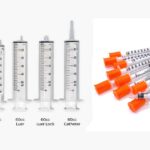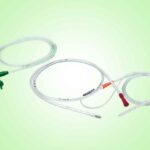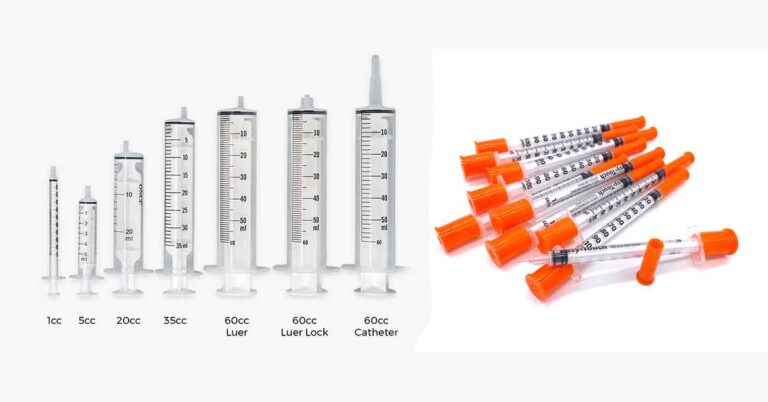An insulin syringe is similar to other syringes, as they have the same essential features. However, the insulin syringe is designed for use in injecting insulin in diabetic patients through the subcutaneous tissue (immediately below the skin). Patients with type-1 diabetes may inject insulin up to 4 or 5 times daily.
Injection to the subcutaneous tissue requires a smaller, shorter, and finer. Since the quantity of the insulin given is not usually large, insulin syringes are designed with a slimmer barrel and smaller needle. Thinner needles are more comfortable, while thicker needles allow for quicker administration of the insulin.
Apart from insulin syringes, there are other insulin injection devices such as insulin pens, and pumps.
Parts of the Insulin Syringe
The insulin syringe has parts such as the needle, needle cap, gasket, barrel, plunger, and the plunger cap (available in insulin syringes with fixed needles).
The needle:
The needle is thin, short, finer, and has a layer of silicone to allow the smooth passage through the skin with less pain. It has a cap that covers and protects it before use.
The Barrel:
A long, thin tube-like and cylindrical chamber holding the insulin before injection is the barrel. It has markings with a line on the side to measure the number of insulin units. The markings are in form of the International Units (IU). The size of the barrel is expressed in milliliter, with each size showing the amount of insulin to be injected. At most, the insulin syringe is provided with 100-unit barrels.
The Plunger:
The plunger is the long, thin rod that fits securely inside the syringe barrel. It slides up to draw insulin into the barrel, or down to push the insulin out of the barrel through the needle.
It has a rubber tip called gasket at one end, and a plastic disc on the other. The rubber seal at the lower end of the barrel prevents leakage, and is matched with the lines on the barrel to ensure the correct amount of insulin is measured. Pushing the disc on the plunger will cause the rubber tip to push insulin out of the barrel through the needle.
Different Types and Sizes of the Insulin Syringes
There are different sizes of the insulin syringes, ranging from 28 to 31. The higher the gauge, the slimmer the needle. It is advisable to use the smallest possible insulin syringe for the insulin dose to be given.
Sizes of Insulin Syringes
| Length of insulin needle | Needle gauge | Barrel size |
| 3/16 inch (5 mm) | 28 | 0.3 ml |
| 5/16 inch (8 mm) | 29, 30 | 0.5 ml |
| ½ inch (12.7 mm) | 31 | 1.0 ml |
Types of Insulin Syringes
There are two types of insulin syringes. The syringes with fixed needles, and the syringes with detachable needle or no needle.
Insulin syringes that have fixed needles
This type come in sizes such as 0.3, 0.5, 1.0 ml. It also has a needle, needle cap, gasket, barrel, plunger, and a plunger cap. The different sizes of the barrels expressed in millimeters, and corresponding to the dose of insulin include:
- 1/3 mL or 0.33 mL: Holds 30 units of insulin, and are numbered at 1-unit intervals. Also, suitable for children and people with poor eyesight.
- 1/2 mL or 0.50 mL: Can hold between 30 and 50 units of insulin, and are numbered at 1-unit intervals.
- 1 mL: Holds 100 units of insulin, and are numbered at 2-unit intervals. They are suitable for adults requiring large dose of insulin.
Insulin syringes with the detachable needle or without the needle
These types have parts like needle, needle cap, gasket, barrel, plunger but no plunger cap. It is available in sizes such as the sizes of 0.5 and 1.0 ml.
- 1/2 mL or 0.50 mL: Can hold between 30 and 50 units of insulin, and are numbered at 1-unit intervals.
- 1 mL: Holds 100 units of insulin, and are numbered at 2-unit intervals. They are suitable for adults requiring large dose of insulin.
Precautions while using Insulin Syringes
- Disposable syringes are meant for single use, after which it is properly discarded
- Do not clean the syringe with alcohol, as it removes the silicone covering on the needle, making it dull.
- Store the syringe in the room temperature
- If the needle must be re-used, patients with open wounds, and those with visual impairment, should not re-use the syringes
- If the syringe still has insulin inside, store by the needle by covering it and pointing it up to prevent the blockage of the needle by the insulin
- When covering the needle, only the inside of the cover should touch the needle. It should not touch the finger or any surface.
Reference:
- https://myhealth.alberta.ca/Health/pages/conditions.aspx?hwid=hw39086
- https://www.nphealthcarefoundation.org/media/filer_public/ef/e2/efe223b2-59eb-4dd2-9b39-407ab995e786/3_insulin_syringes.pdf
- https://www.kmedhealth.com/what-is-the-insulin-syringe/
- https://www.betterhealth.vic.gov.au/health/conditionsandtreatments/diabetes-and-insulin












